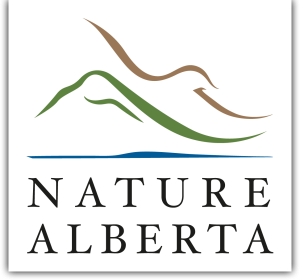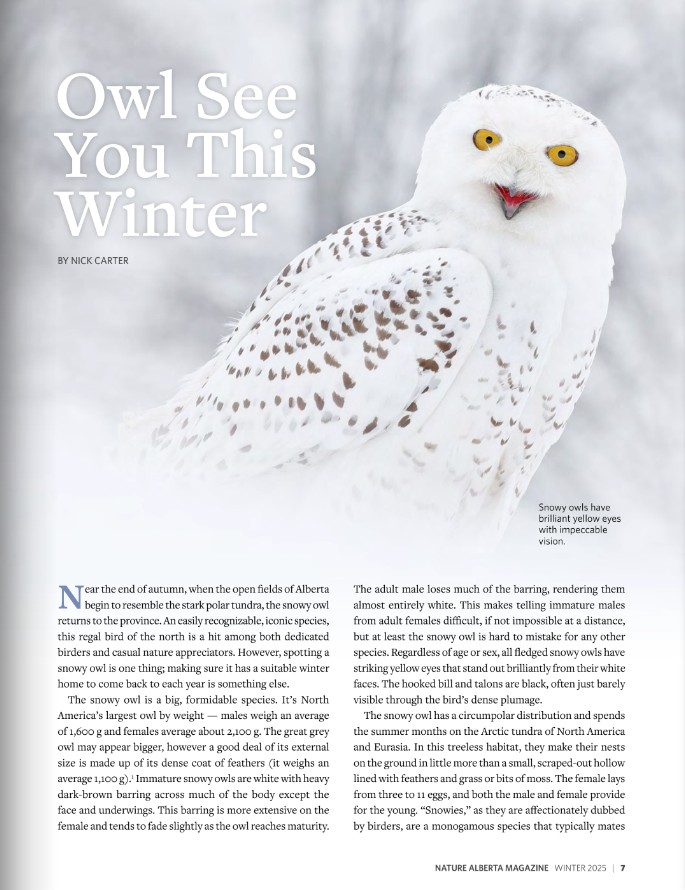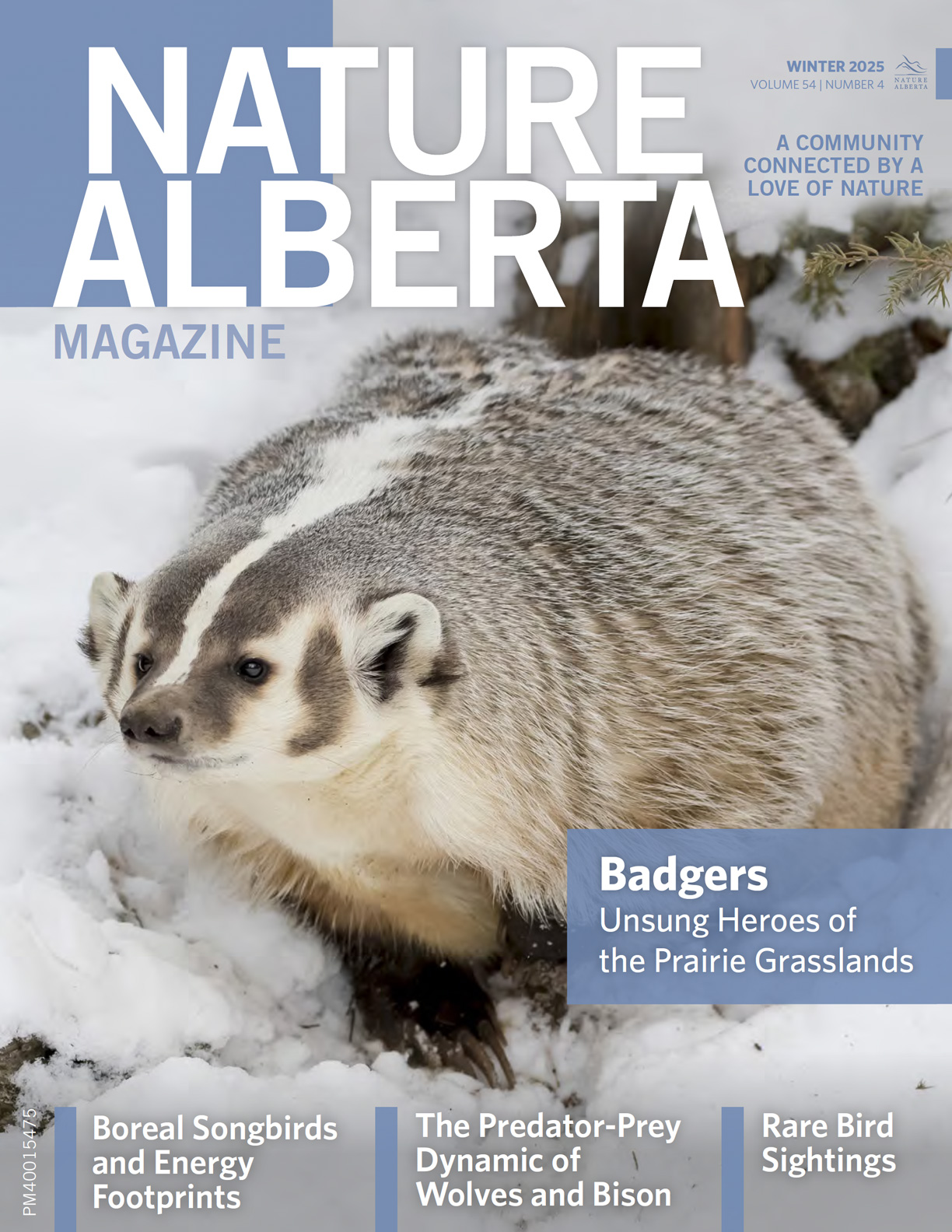Owl See You This Winter
11 February 2025
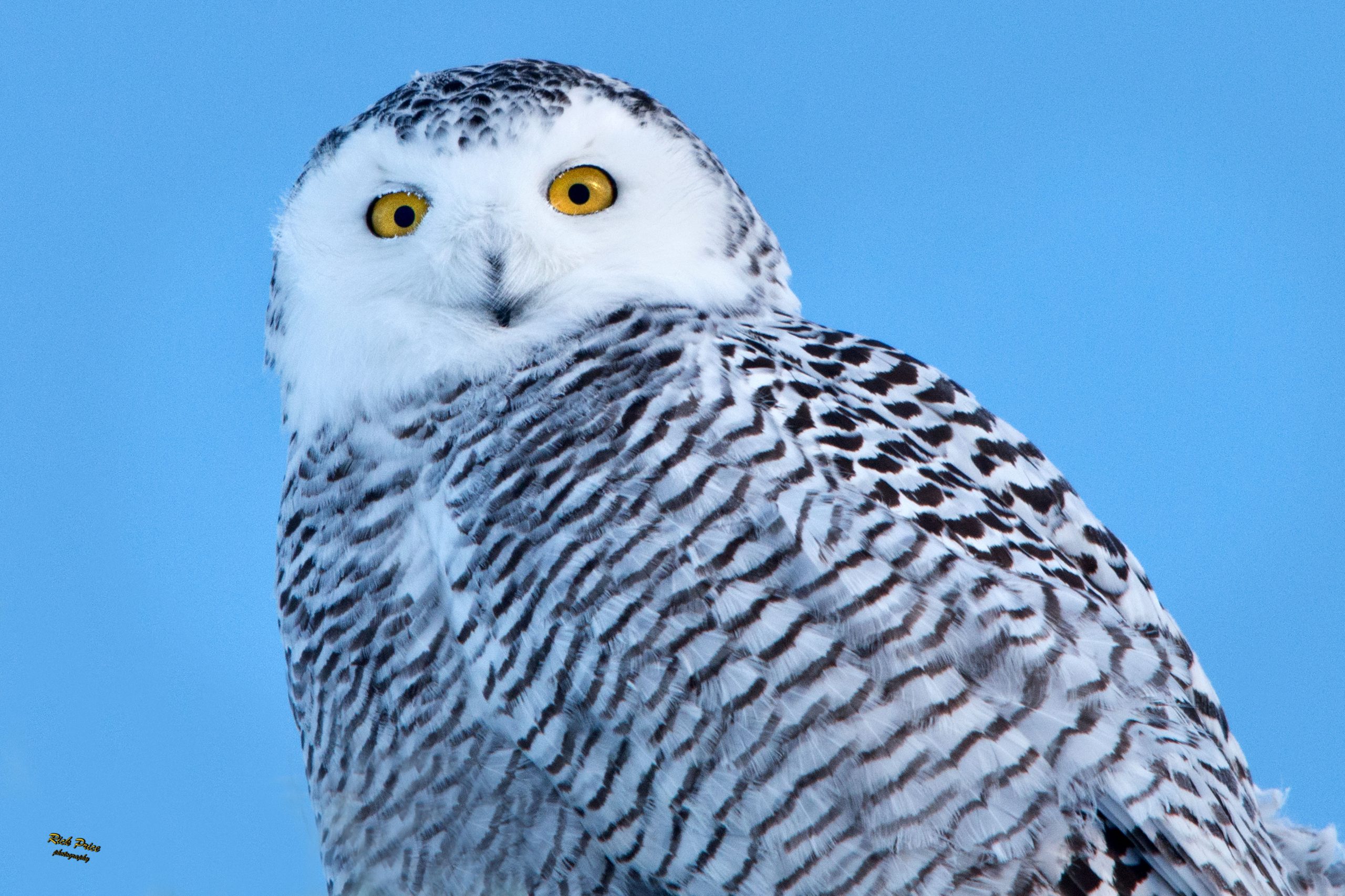
By NICK CARTER
Near the end of autumn, when the open fields of Alberta begin to resemble the stark polar tundra, the snowy owl returns to the province. An easily recognizable, iconic species, this regal bird of the north is a hit among both dedicated birders and casual nature appreciators. However, spotting a snowy owl is one thing; making sure it has a suitable winter home to come back to each year is something else.
The snowy owl is a big, formidable species. It’s North America’s largest owl by weight — males weigh an average of 1,600 g and females average about 2,100 g. The great grey owl may appear bigger, however a good deal of its external size is made up of its dense coat of feathers (it weighs an average 1,100 g).1 Immature snowy owls are white with heavy dark-brown barring across much of the body except the face and underwings. This barring is more extensive on the female and tends to fade slightly as the owl reaches maturity. The adult male loses much of the barring, rendering them almost entirely white. This makes telling immature males from adult females difficult, if not impossible at a distance, but at least the snowy owl is hard to mistake for any other species. Regardless of age or sex, all fledged snowy owls have striking yellow eyes that stand out brilliantly from their white faces. The hooked bill and talons are black, often just barely visible through the bird’s dense plumage.
The snowy owl has a circumpolar distribution and spends the summer months on the Arctic tundra of North America and Eurasia. In this treeless habitat, they make their nests on the ground in little more than a small, scraped-out hollow lined with feathers and grass or bits of moss. The female lays from three to 11 eggs, and both the male and female provide for the young. “Snowies,” as they are affectionately dubbed by birders, are a monogamous species that typically mates for life. After about a month of incubation, the fuzzy greyish-white owlets hatch, and within another month’s time they have left the nest for good.2
The snowy owl is a medium-distance migrator. In November, North American snowies move south, leaving the Canadian tundra and migrating as far south as the U.S. border. The snowy owl is an irruptive species, appearing in large numbers one year and then essentially absent the next, depending on food availability across its range. On the tundra, it feeds almost exclusively on lemmings, though it may also hunt other small mammals and birds such as waterfowl and ptarmigan. In Alberta, it can show up just about anywhere with suitable habitat and typically stays until the end of March if there’s enough to eat. Their winter diet includes voles, mice, rabbits and hares, and the occasional songbird or duck. During this time, the snowy owl is typically a solitary bird, but occasionally multiple individuals share a wintering area encompassing just a couple square kilometres.3 Juveniles seem to be especially willing to share space with one another. Many Edmonton-area birders may fondly remember the winter of 2018–2019, when two juvenile snowy owls spent at least part of the winter along Ray Gibbon Drive on the western edge of St. Albert. In good years and in the right place, birders can be treated to sightings of multiple snowy owls in a day without too much difficulty.
Fortunately for us, snowy owls are one of the most diurnal owl species, so you don’t have to go out in the cold, dark woods at night to find them. Instead, drive open country roads by day and watch for distinctive white shapes, like little snowmen basking in the winter sun. It can take some practice to recognize them at a distance, though, and even experienced owl watchers have been fooled for a moment by the sight of a lump of snow or a white bit of garbage caught in a tree. Snowies also perch on roadside utility poles, fence posts, treetops, or anything else that offers them a good view of the landscape. Sturgeon County north of St. Albert, the prairies east of Calgary, and the rolling farmland west of Grande Prairie are among the more reliable snowy owl viewing areas in the province. While not often seen within busier human settlements, smaller cities and towns may host one or more snowy owls on any given winter. Airports can be a favoured area, as they offer plenty of flat, open space with convenient perches.
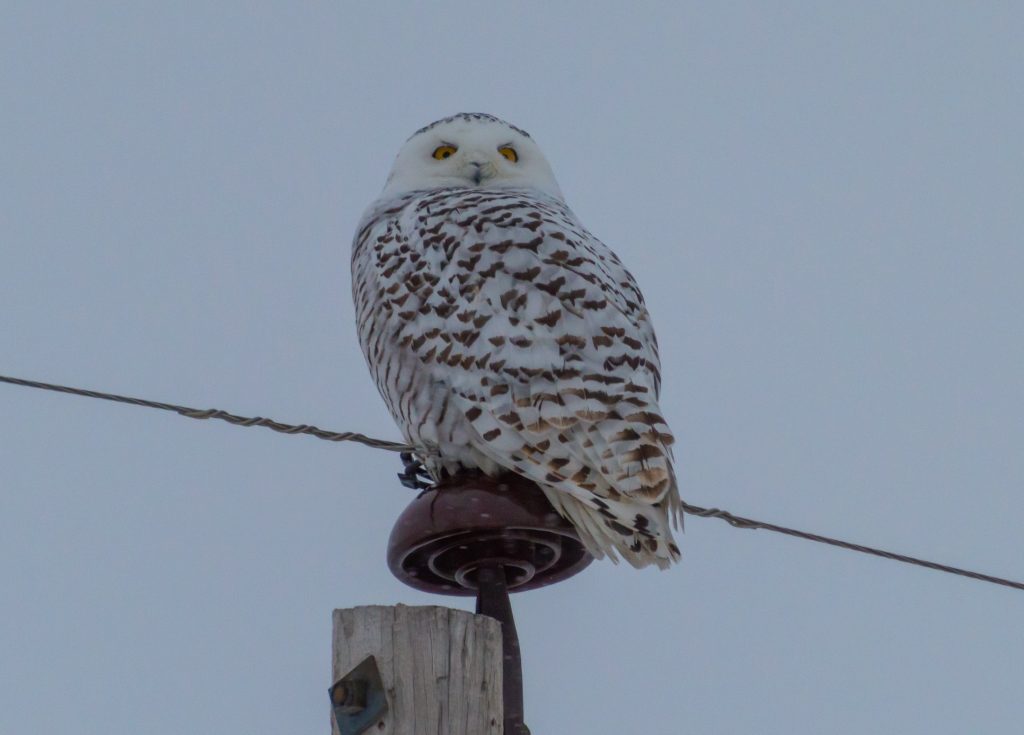
Electrocution from power lines continues to be an unfortunate source of mortality for snowy owls. NICK CARTER
When out watching snowy owls, keep in mind the rules of ethical birdwatching. Like other owl species, snowy owls need their space and become stressed when we get too close and spend too long with them, no matter how drowsy and unbothered they might seem. All birds need a time and place to rest, digest, or look for more food. Humans crowding around with binoculars and cameras make birds like this uncomfortable, often interrupting what they were doing and causing them to waste more energy going to look for a quieter place to perch. Birdwatchers would do well to always prioritize the comfort and well-being of the bird over getting a closer look or a cool photo.
The irruptive and nomadic nature of this species, combined with its remote breeding habitat, make snowy owl populations difficult to assess with certainty. While it is listed as “Secure” in Alberta, internationally the snowy owl is regarded as “Vulnerable” and declining rapidly by the International Union for Conservation of Nature (IUCN).4 While the breeding range of this species is minimally affected by direct human interference, climate change is an ongoing threat to prey and habitat availability in the Arctic. Threats in the wintering range include immediate dangers like collisions with vehicles or electrocution from power lines because of the owl’s habit of perching on utility poles. Additionally, as more of Alberta’s rural land gets converted into suburbs and other human developments, snowy owls will gradually have less room here to spend the winter.
Spotting a snowy owl sure makes toughing out the long, dark, cold months of winter in Alberta a little easier. This beautiful and uplifting species is a real symbol of the north, and hopefully we can make sure that Alberta continues to be a welcoming winter home for this species far into the future.
References
- Sibley, David Allen (2024). The Sibley Field Guide to Birds of Western North America. Alfred A. Knopf, New York.
- The Cornell Lab of Ornithology. https://www.allaboutbirds.org/guide/Snowy_Owl
- Holt, Denver W. and Steven A. Zetterberg (2008). The 2005 to 2006 Snowy Owl Irruption Migration to Western Montana. Northwestern Naturalist. 89(3):145-151. doi:10.1898/NWN07-19.1
- BirdLife International (2021). Bubo scandiacus. The IUCN Red List of Threatened Species 2021: e.T22689055A205475036. https://dx.doi.org/10.2305/IUCN.UK.2021- 3.RLTS.T22689055A205475036.en
Nick Carter is a naturalist and science communicator from Edmonton and is Nature Alberta’s Nature Kids Coordinator. He studied biology at the University of Alberta and has had a lifelong fascination for all things in the natural world.
Read the Original Article for this Post
For a richer reading experience, view this article in the professionally designed online magazine with all images and graphs in place.
This article originally ran in the Winter 2025 issue of Nature Alberta Magazine (Vol. 54 | No. 4).
